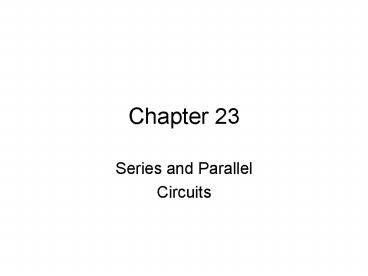Series and Parallel PowerPoint PPT Presentation
1 / 15
Title: Series and Parallel
1
Chapter 23
- Series and Parallel
- Circuits
2
Series and Parallel Review
3
"1. The same current flows through each part of a
series circuit."
Series Rules
4
"2. The total resistance of a series circuit is
equal to the sum of individual resistances."
RT R1 R2 R3 5 5 10 20 Ohms R
total is 20 Ohms
5
Now with these two rules we can learn how to
calculate the amperage of a circuit
Lets follow our example figure RT R1 R2
R3 RT 20 Ohms I V / RT I 20V / 20
Ohms I 1 Amp
6
Before we go any further let's define what a
"voltage drop" is. A voltage drop is the amount
the voltage lowers when crossing a component from
the negative side to the positive side in a
series circuit. If you placed a multimeter
across a resistor, the voltage drop would be the
amount of voltage you are reading. This is
pictured with the red arrow in the diagram.
Say a battery is supplying 10 volts to a circuit
of two resistors each having a value of 5 Ohms.
According to the previous rules we figure out the
total resistance. RT R1 R2 5 5 10
Ohms Next we calculate the amperage in the
circuit I V / RT 10V / 10 Ohms 1 Amp
Now that we know the amperage for the circuit
(remember the amperage does not change in a
series circuit) we can calculate what the voltage
drops across each resistor are using Ohm's Law (V
I x R). V1 1A x 5 Ohms 5 V V2 1A x 5
Ohms 5 V
7
"3. Voltage applied to a series circuit is equal
to the sum of the individual voltage drops."
This simply means that the voltage drops have to
add up to the voltage coming from the battery or
batteries. V total V1 V2 V3 ... In our
example above, this means that 5V 5V 10V.
"4. The voltage drop across a resistor in a
series circuit is directly proportional to the
size of the resistor." This is what we described
in the Voltage Drop section above. Voltage drop
Current times Resistor size.
The best way to illustrate this is with a string
of light bulbs. If one is burnt out, the whole
thing stops working.
8
Parallel Rules
9
You may remember from the last section that the
voltage drops across a resistor in series. Not so
with a parallel circuit. The voltage will be the
same anywhere in the circuit.
10
"3. The sum of the currents through each path is
equal to the total current that flows from the
source."
11
1 1 1 1 -- -- -- -- Rt R1
R2 R3 Therefore 1 1 1 1 -- --
-- -- Rt 4 4 2 It is easiest to
change the fractions into decimal numbers
(example 1 divide by 4 equals .25) 1/Rt .25
.25 .5 1/Rt 1 Now you have to get rid of
the 1 on the left side so... Rt 1/1 Rt 1
Ohm
12
Before we move on to the last rule I want to show
you how easy it is to calculate the amperage
through each path using OHM'S LAW.In the
example we see a 10 and 20 ohm resistor in
parallel with a 10 Volt source. First we figure
out the total resistance of the circuit1/Rt
1/10 1/20Rt 6.67 OhmsNow you know this
you can figure out the total amperage (It) using
Ohm's Law I total (It) 10V / 6.67 Ohms 1.5
AmpsTherefore the total amperage between the
two resistive paths must equal 1.5 Amps (Rule 3).
Now we can figure out exactly what each path is
pulling using Ohm's Law once more. Remember that
the voltage is the same everywhere in a parallel
circuit. So we know the voltage and the
resistanceI1 10V / 10 Ohm 1 A I2 10V /
20 Ohm .5 A We figured the total amperage
(It) previously, so now we can double check if
the figures are correctI1 I2 It1A .5A
1.5A - check
13
The best way to illustrate this is also with a
string of light bulbs in paralallel. If one is
burnt out, the others stay lit.
14
(No Transcript)
15
Homework
- Pages 636 638
- Numbers 37,38,45,46,52,55,65,81

